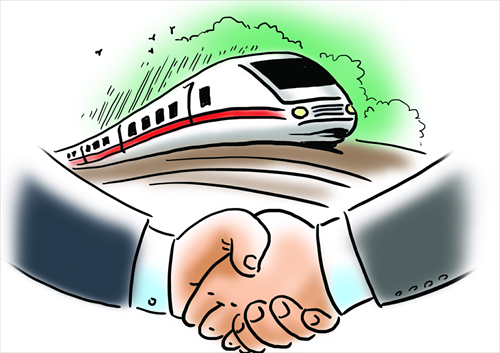Belt, Road a boon to Central, Eastern Europe

Illustration: Liu Rui/GT
Chinese President Xi Jinping is currently on an official tour to Serbia and Poland. He visited the Czech Republic in March. China has been embarking on a connectivity-oriented foreign policy. Central and Eastern European countries have played an increasingly vital role in China's diplomacy and they are key partners in China's "One Belt and One Road" initiative.
Serbia is an important country in the Balkan Peninsula. It is located in a unique geographic position that borders with eight countries. In 2009, China and Serbia established a strategic partnership, China's first such relationship in Central and Eastern Europe. A favorable bilateral political relationship is shifting toward the main driving force for economic cooperation. Serbia firmly believes that the China-proposed "Belt and Road" program is a significant opportunity for its own development.
In January 2013, leaders from China, Serbia and Hungary envisioned the Hungary-Serbia railway project, which achieved concrete progress in 2015. The line between Belgrade and Budapest, the capitals of Serbia and Hungary, will shorten the travel time from eight hours to just three hours.
The Hungary-Serbia railway is the northern part of the China-Europe express line consisting of sea routes and land transport systems, which is a key point of cooperation between China and Europe under the framework of "Belt and Road" initiative.
After the global financial crisis, the EU cut its investment in Serbia. When Western companies were reluctant to undertake investment risks and hesitant to move on, Chinese entrepreneurs saw hope. Besides the Hungary-Serbia railway, Chinese enterprises helped construct the bridge over the Danube in Belgrade and other highway projects.
China has not only accelerated the improvement of transportation facilities in Serbia, but also broadened support for its industries. In April, Chinese company Hebei Iron and Steel Group signed a 46 million-euro ($52 million) agreement to buy the loss-making steel plant in Smederevo. China Road and Bridge Corp. will also cooperate with the government of Belgrade to build projects such as Chinese industrial parks.
Similar to Serbia, Poland has always been an active participant in the "Belt and Road" initiative. Polish President Andrzej Duda has said that Poland could become a kind of a logistics center for the initiative. In 2011, China and Poland established a strategic partnership. In 2015, bilateral trade exceeded $17 billion. Poland also joined China-led Asian Infrastructure Investment Bank as a founding member, the only country from Central and Eastern Europe.
China believes Poland has huge economic potential. It has not only regional and geographic advantages, but also complete industrial patterns. In 2016, the country's GDP growth is expected to reach 4 percent, a fast speed among European countries.
In recent years, Poland has been trying to find how to raise its influence on China. So far, Chinese cities such as Chengdu and Suzhou have launched freight trains that lead all the way to Poland's Warsaw and Lodz.
To better enhance cooperation between companies from both countries, Poland started offering consular services in Chengdu. The Lodz government has also set up an office in Chengdu. Such cooperation at sub-national levels has become institutionalized, which has become a highlight in China-Poland relations.
Support from the EU is particularly important if Beijing is to deepen cooperation with Central and Eastern European countries. The EU-China connectivity platform has been established, which will be used to link the "Belt and Road" initiative with the Juncker Plan. In November 2014, European Commission President Jean-Claude Juncker announced a 315-billion-euro investment plan to get this continent growing again and get more people back to work.
To address concerns from the EU, China has proposed to include its connectivity programs with Central and Eastern European countries within the framework of China-Europe infrastructure cooperation. In January, China became a member of the European Bank for Reconstruction and Development and the two sides will strengthen financing cooperation in Central and Eastern Europe.
Besides, to ease anxieties from old European powers such as France and Germany, China raised the notion of cooperation with a third party in Central and Eastern Europe.
China is trying to make its own industrial capacity advantages match the needs of the region and link to key technologies of developed countries in Western Europe. It has no intention to occupy the market of the region. Xi's visit to Serbia and Poland shows China's determination to push forward the "Belt and Road" initiative. It is expected to bring in more members from Central and Eastern European countries or even other EU countries to participate in it. This is a triple-win cause for China, Central and Eastern Europe and the EU.
The author is a research fellow at the Charhar Institute and an adjunct fellow at the Chongyang Institute for Financial Studies at Renmin University of China. opinion@globaltimes.com.cn